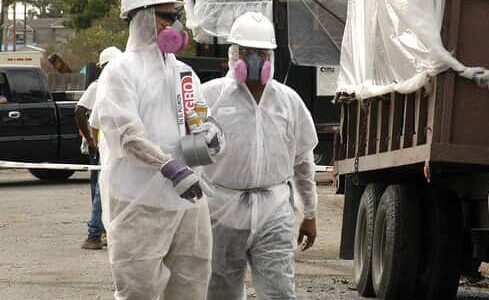Asbestos was a commonly-used building material until the year 2000 and can be found in any structure built or renovated before this date, including both residential homes and commercial properties. When disturbed, asbestos releases tiny fibres that are breathed into the lungs, which can eventually lead to serious and often fatal health conditions. Asbestos kills 5000 people a year, with around 20 tradespeople dying every week as a result of past exposure to asbestos.
What Are the Health Risks of Asbestos?
Disturbing or damaging asbestos when carrying out refurbishment or building work causes fibres to be released into the air. When inhaled, these fibres can cause serious diseases which can take a long time to develop, but which are often untreatable once diagnosed. That’s why care should be taken when working in areas where asbestos might be found, and an asbestos survey should always be carried out when you suspect the presence of asbestos.
Exposure to asbestos can cause a cancer called mesothelioma, which affects the lining of the lungs and the lining around the lower digestive tract. It is almost always fatal. There is also a type of asbestos-related lung cancer that looks similar to lung cancer triggered by smoking and other causes. Generally, smokers are also at an increased risk of asbestos-related health problems.
Heavy exposure to asbestos over many years can lead to asbestosis, which is a serious scarring of the lungs that leads to shortness of breath. In severe cases, this can be fatal. Pleural thickening is another side-effect of breathing in asbestos fibres which causes the lining of the lung to thicken, which can lead to shortness of breath and chest pain.
Different Types of Asbestos
Asbestos can be found in different forms and in many areas of a building. Asbestos insulating board, or AIB, was commonly used as a fireproofing material and as ceiling tiles and window boards. AIB is also found in office partitioning and in the fireproof panels within fire doors.
Sprayed coatings contain up to 85% asbestos and were commonly used as insulation in roof spaces, on the sides of buildings, and applied to steel and concrete beams and columns for fire protection.
Loose-fill asbestos, which is made of pure asbestos, was used as an insulation material in lofts, between cavity walls, and underneath the flooring. This is the most dangerous asbestos-containing product and releases a large number of fibres when disturbed.
How to Protect Yourself from Asbestos
If you are a tradesperson working in refurbishment, maintenance, or demolition, you could be exposed to asbestos. The risk is increased if asbestos has not been identified before work begins or you are working on an unfamiliar site constructed before 2000. Remember that asbestos fibres aren’t visible to the naked eye and the effects of exposure can take years to develop.
Asbestos only poses a risk when it is disturbed and the fibres are released into the air, so as long as it is in good condition and can’t be easily damaged, then you won’t be at risk.
The person responsible for maintaining non-residential buildings has a duty to manage asbestos and should make you aware of any asbestos in the building before you begin work.
If no information is provided, always stop work immediately if you suspect that asbestos is present. A risk assessment should be carried out to establish if a licensed contractor is needed to remove the asbestos. Anyone who is likely to disturb asbestos during their work should also be given appropriate training to manage the risks of asbestos exposure.
How to Detect Asbestos
Asbestos can be difficult to detect as it is often contained within other materials. Also, the different types of asbestos mean that it is found in many areas and in a variety of forms.
The Health and Safety Executive has an asbestos image gallery which details some of the most common areas where asbestos can be found, but the best way to know for sure if asbestos is present is to arrange a survey from a licensed contractor.
Arrange a Survey Today
Clearview Environmental is accredited as a testing laboratory and inspection body and has more than 25 years of experience working with asbestos. To minimise the risks of asbestos in a building, get in touch using our contact form or call 0116 288 8256 to arrange a survey.
Posted in Latest News, Asbestos

